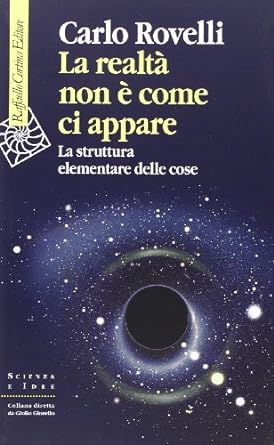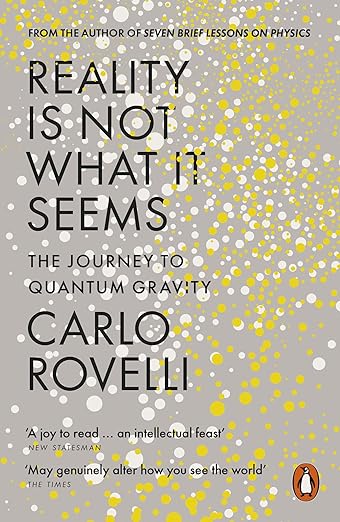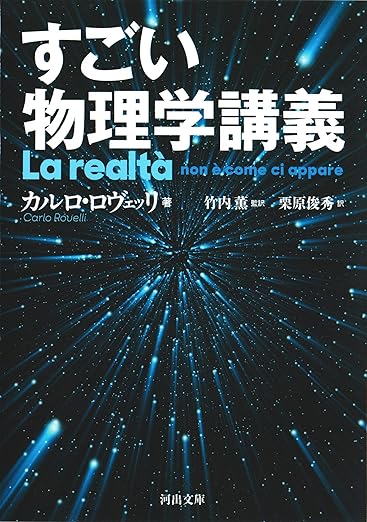


すごい物理学講義 (Time doesn’t exist)
by Carlo Rovelli
書評「めぐりあう書物たち」 (Book review ”Book come across”)
by 尾関章 (Akira Ozeki)
Recently, this column has been confronting the mystery of time. The reason is probably because I’m older. Every day is so precious. To put it more simply, I love every moment. However, you cannot capture that moment and save it somewhere. There is no cryopreservation in time.
In May of this year, I read “Time Doesn’t Exist” by theoretical physicist Carlo Rovelli (translated by Sei Tominaga, published by NHK Publishing, 2019). The emphasis was on the fact that physics can work without time. Physical phenomena can be described without the time variable “t”. If you use mathematical formulas to relate the way one quantity changes to the way another quantity changes, you can accomplish the mission of physics – it’s surprising when you think back to science class, but it was a point that made sense once you heard it. .
However, this cannot explain how we experience time every day. What makes “Time Does Not Exist” admirable as a book for the general public is that it does not ignore its drawbacks. The author, Rovelli, used thermodynamic considerations to reveal the true nature of time as we humans perceive it.
However, since I was a science reporter, I would like to take a step closer to Rovelli’s physics, which says that there is no need for time. What kind of philosophy did he draw from? How is he trying to change his worldview? There are many things I want to dig into. So this time I will be looking at another book by the same author. Coincidentally, this column, including its predecessor column, has now reached its 700th anniversary. I once had a sign saying “Bunri Yuyu” in the name of my column, so I think it’s a fitting choice for this milestone.
“Amazing Physics Lecture” (written by Carlo Rovelli, translated by Kaoru Takeuchi, translated by Toshihide Kurihara, Kawade Bunko, published in 2019). This is a paperback version of the Japanese translation published by Kawade Shobo Shinsha in 2017. The original book was published in Italy in 2014, three years earlier than the original publication of “Time Doesn’t Exist.”
The author is from Italy. He is searching for a theory that integrates quantum mechanics and general relativity, and advocates the “loop quantum gravity theory” as a trump card. This theory is tied to cosmology and is deeply concerned with what happened at the beginning of the universe. This is one of the reasons why I am trying to read this author’s book again. If time does not exist in physics, as “time does not exist” says, then what was the origin of the universe? I would like to get that hint as well.
Let’s get into the contents of this book. Chapter 1, “Grains: The Great Discovery of Ancient Greece” states, “The universe is granular and does not continue smoothly.” Its origin seems to be the atomic theory of the ancient Greek philosopher Democritus. The idea is that the work of cutting the universe into pieces cannot continue indefinitely, and this has the advantage of resolving Zeno’s paradox that the hero Achilles cannot catch up with the tortoise. As you read this book, you will find that the author also takes the position of Democritus.
This is where the word “granularity” comes from. The author says that “at the root of all things” is “the nature of particles.” Quantum theory considers that electromagnetic waves are also swarms of photons (particles of light), but quantum gravity theory seems to believe that space and time also have “granularity.”
This book cites former Soviet physicist Matvey Bronstein (1906-1938) as a pioneer in this research. He viewed space as a “continuum that can be infinitely divided” and published a paper in the 1930s that showed that quantum mechanics and general relativity were incompatible. He theoretically proved that if quantum mechanics and general relativity are both correct, space has a “granular” quality. This man was sentenced to death for criticizing the Stalinist regime in the former Soviet Union, and was executed at a young age.
This is how the proof works. If you try to place a particle in a very small region of space, that particle will follow Heisenberg’s uncertainty principle and try to escape from that region at extremely high speed. The energy of the particles becomes enormous. According to general relativity, the result is that space bends so much that its interior becomes unobservable. In modern terms, this creates a black hole. It can be said that “areas below a certain scale” are “inaccessible” and therefore nothing exists there.
Bronstein calculated that “certain scale”. This can be obtained by multiplying Planck’s constant h by Newton’s gravitational constant G, dividing it by the cube of the speed of light c, and taking the square root of the result. It will be done. h is a fundamental constant related to the discrete values of energy in quantum theory. c is a constant essential to relativity theory. A calculation formula that includes both is suitable for attempting to reconcile quantum mechanics and general relativity. The value thus obtained was the “minimum length” that exists in the world.
This length is 1 trillionth of 1 trillionth of 1 cm (10 to the minus 33rd power cm). The physics community has named this the “Planck length,” but the author says, “I would like to call it the “Bronstein length.” This is probably a tribute to the pioneers of quantum gravity theory.
John Wheeler (1911-2008), a prominent American physicist, made a major contribution to the development of quantum gravity theory. It is said that it was because of this person’s intention that a celestial body that collapses due to gravity came to be called a black hole. According to the book, Wheeler was able to visualize quantum space in a single image after carefully reading Bronstein’s paper. It was “a cloud-like thing made of different geometric figures overlapping each other.”
Speaking of “cloud”, the electron cloud of quantum mechanics comes to mind. When we consider the electrons around the atomic nucleus using Schrödinger’s equation, they do not exist at a single point unless they are observed, but instead exist in a series of overlapping states at various positions. It is a “cloud of probability.” According to the theory of quantum gravity, does this mean that space is similar? However, it is not the positions of the electrons that overlap, but the shapes of the geometric figures. I feel like I understand something, but this alone doesn’t make sense.
The author compares this to the sea level. If you look at the ocean from above, it looks like a flat, blue plate, but if you get closer, you’ll see bubbles floating here and there. When viewed macroscopically, space is “flat and smooth” and follows Euclidean geometry, but this is not the case with microscopic scenery.
For example, suppose we look into a world where the scale of a ruler is as small as Planck’s length. Space is there “chopped and bubbling.” The book explains that this “bubbling of space” is “a wave of probability made up of different geometric figures.”
What was brave about Wheeler was that he attempted to describe the “bubbling of space” using a mathematical formula. He was collaborating with a young researcher, Brice de Wit. In the 1960s, the two discovered the “Wheeler-de Witt equation.” It was estimated that the probability of observing a particular curved space could be determined from this formula. If successful, it will be a quantum gravity theory version of Schrödinger’s equation that gives the probability that a particular particle state will be observed.
So, did you solve the Wheeler-de Witt equation as expected? I’d like to go into that, but I’ve run out of lines this week. I’ll be taking up this book again next week and talking about it.
This time, I would like to add one more thing about the Wheeler-de Witt equation. In “Time Doesn’t Exist,” the author described this formula as “pointing out possible relationships between varying quantities without involving the time variable.” This book says the same thing.
According to modern cosmology, the universe began in an ultra-microscopic world. According to quantum gravity theory, the author’s position seems to be that it can be drawn without the time variable “t”. The world became what it is today due to rapid expansion (inflation) or a big explosion (big bang).
What I would like to mention here is Stephen W. Hawking’s theory. It is said that there was an imaginary amount of time at the beginning of the universe. At this time, “Time and space may come together to form a curved surface of finite size but without any boundaries or edges.” (“Hawking talks about the universe: From the Big Bang to black holes.” “Until” (written by Stephen W. Hawking, translated by Kazu Hayashi, Hayakawa Bunko NF). Is it impossible to distinguish between time and space?
Whether you accept the Wheeler-de Witt equation or support Hawking’s cosmology, it seems that when thinking about the beginning of the universe, you should put time aside and focus on space for now. The question is, what is the space like? That’s what we’ll focus on next week.
めぐりあう書物たち/尾関章
「読む」「考える」の by chance
2023年10月20日 投稿者: AKIRA OZEKI
ロヴェッリの物理、空間は粒
https://ozekibook.com/2023/10/20/ロヴェッリの物理、空間は粒/